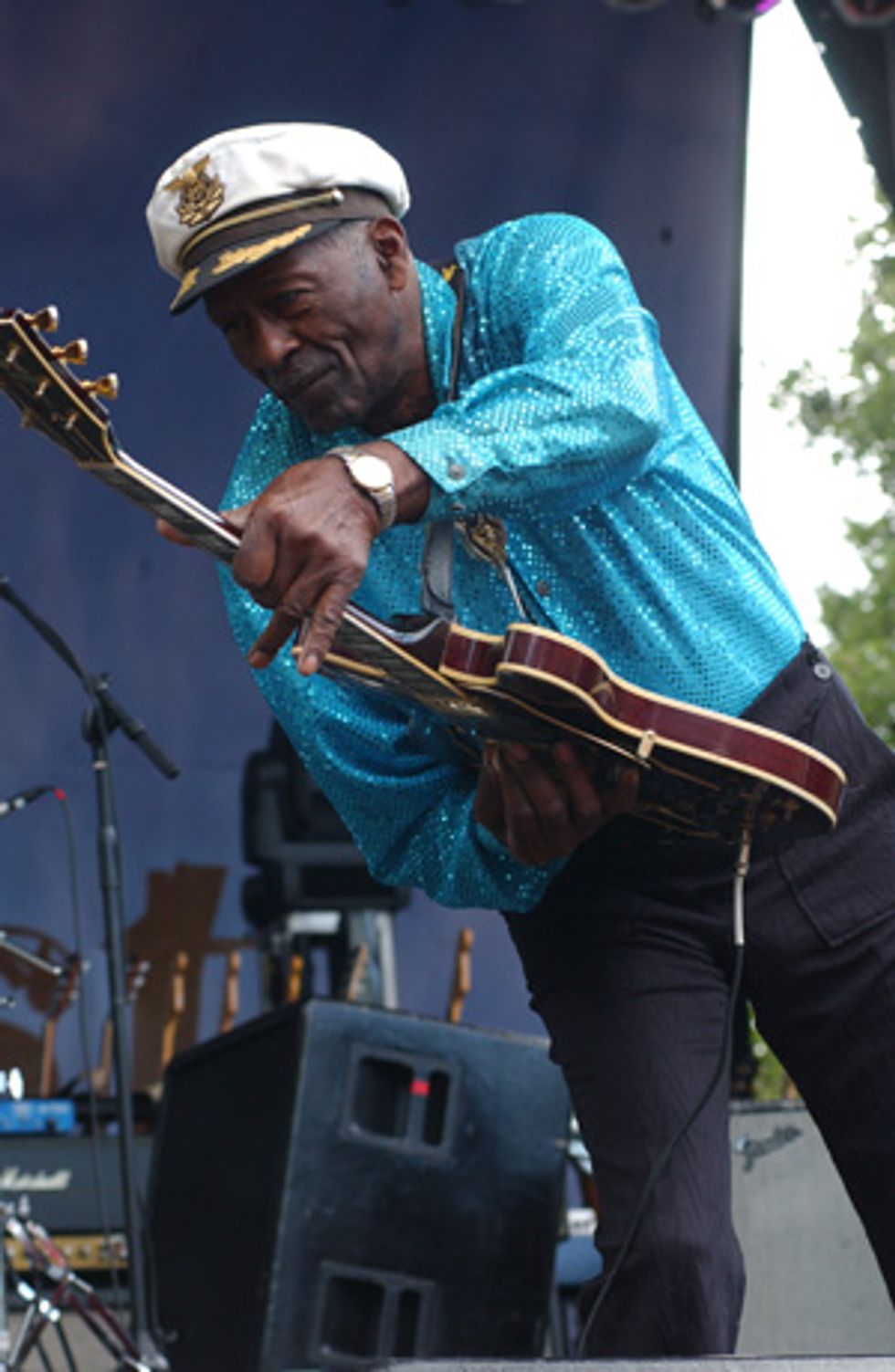If all Chuck Berry had done was write the brilliant, guitar-driven, 3-minute operettas that stoked the flames of early rock ’n’ roll—“Maybellene,” “Roll Over Beethoven,” “Too Much Monkey Business,” “You Can’t Catch Me,” “School Day (Ring Ring Goes the Bell),” “Rock and Roll Music,” “Sweet Little Sixteen,” and “Johnny B. Goode”—between the summer of 1955 and spring ’58, his place in history would be assured. But Berry did much more. His writing was clever and articulate, and fractured the Tin Pan Alley-version of songwriting, in which Svengalis of the pen and piano manufactured songs for artists.
Berry’s personal vision of the popular song, with his detailed, literate language and emphasis on relatable storytelling, paved the way for future do-it-all musician laureates like Bob Dylan and the Beatles. And electric guitarists who claim to not have been influenced by Berry are either lying or ignorant of how deeply his distinctive style is embedded in the core DNA of the instrument’s sound and vocabulary. His chugging and sliding chords, slurs, multi-string bends aimed at creating light brushstrokes of dissonance, and the punctuation of his phrasing—where the influence of his hero T-Bone Walker shined particularly bright—expanded the experience of hearing and playing the electric guitar beyond its role in the jazz, blues, and pop of the early ’50s. On one hand his playing was virtuosic; on the other, accessible enough—versus the intricacies of players like Les Paul and Chet Atkins—that any aspiring Johnny B. Goode with a paper route could suddenly dream of saving up for a guitar and leaving home behind, with or without a gunny sack.
And there’s more to the importance of Berry, who died at his home in Wentzville, Missouri, on Saturday, March 18, at age 90. His music and his concerts are where black and white American mainstream culture in the age of Jim Crow met. At a time when the racial divide was sharply and institutionally defined, teenagers were united in the joy of sharing Berry’s music, which was not always an easy thing for the duck-walking entertainer to accomplish. Thanks to his unaccented diction and across-the-board acceptance on emerging rock ’n’ roll radio, Berry would turn up at Southern concert halls, touring behind his No. 1 smash debut “Maybelline” or one of its chart-busting successors, and watch redneck promoters turn whiter when they realized they’d booked an African-American.
Berry had his own word for describing the kind of receptions he frequently received down South early in his career: “hospitaboo,” a blend of hospitality and taboo. Berry and his band got their first taste of hospitaboo when they were verbally demoted from men to “boys” upon arrival at the Duval Armory in Jacksonville, Florida, in September 1955. Maintenance workers roped off the auditorium’s central aisle, creating a racial no-man’s land that was only crossed at the show’s finale, when white and black audience members stormed the stage together, and exchanged hugs and kisses with Berry and his group as the authorities glared.
Charles Edward Anderson Berry was born on October 18, 1926, in St. Louis, Missouri. He was a middle-class kid but developed a troubled streak that deposited him in prison for armed robbery by age 18. When he got out, he married and, driven by his love for Jay McShann—whose music he sang in a high-school talent show—and other blues and R&B artists, he began to learn to perform and play guitar.
Although his famed shuffling duck-walk was a move that came naturally to him as a child, Berry copped his other stunts—playing over his head, picking with his teeth, dropping the guitar low to the floor between his legs—from T-Bone Walker. Berry’s first big break came on New Year’s Eve 1952, when he was hired by pianist Johnnie Johnson to fill in for an ailing guitarist. He stayed on, and Johnson’s strong rhythmic playing became a foundation of Berry’s music. Although they switched roles as leader in 1955, when Berry got his second big break and signed a contract with Chess Records, they played together steadily until 1973.
In addition to blues and R&B, Berry was a fan of country music, and noticed that when he began incorporating elements of country into his performances, audience enthusiasm increased. His Chess debut, “Maybelline,” was a rewrite of a tune called “Ida Red” that Bob Wills had first popularized. And from ’55 to ’61, Berry put 28 singles on the R&B charts, with a dozen landing in the mainstream Top 40 and forever casting his style of singing, writing, and playing guitar in platinum and gold.
Berry’s initial hits reveal the essential elements of his classic 6-string sound. He played Gibsons throughout his life, using a pair of ES-350 T’s in the period between “Maybelline” and “Johnny B. Goode.” His first was a 1955 with P-90s and the second a ’57 with humbuckers. When the ES-335 was unveiled in 1958, Berry was an early adopter, and he played 335s, 345s, and 355s for the rest of his career. Of course, in the ’50s and early ’60s his guitars were strung with flatwounds, yielding the distinctive “twop” heard on his key singles. And while most rock and blues songs are in common guitar keys, like E, A and G, Berry’s tunes were often in favorite piano keys, like Bb, Ab, and Eb, probably due to Johnnie Johnson’s impact on him. Berry also employed the time-honored African-American church- and blues-music approach, call-and-response, in exchanging vocal lines with his guitar. “School Days” is a perfect example. And he was the first master of the guitar-riff-as-hook, inventing repeating rhythmic figures, like the opener for “Johnny B. Goode,” that were pure ear candy.

Berry leans into a lick with one of the many Gibson ES models he’s played over the decades. He was an early adopter of the ES-335 when it was released in 1958, the year of “Johnny B. Goode.” Photo by Ron Akiyama/AtlasIcons.com
By 1958, Berry was a high-rolling success and invested in real estate around his native St. Louis. He turned one property into Berry’s Club Bandstand. At the end of the next year he was arrested for violating the Mann Act, a federal law established in 1910 to prohibit sexual slavery, for allegedly having sex with 14-year-old Janice Escalante, who he transported across state lines to work as a hatcheck girl at the club. After several years of appealing the conviction, he was compelled to serve 18 months in prison.
In part due to the negative publicity, Berry’s record sales declined, but he was riding another wave of popularity by 1964 thanks to British Invaders like the Beatles and the Rolling Stones, who considered him a profound influence and recorded his tunes. In ’64, Berry also scored with his own salvo, whacking “No Particular Place to Go” and “Nadine” up the charts. Although he remained a popular concert draw, Berry’s next and final hit came in 1972, with the unlikely novelty tune “My Ding-a-Ling,” which reached No. 1 on the U.S. pop singles countdown. But many of his fans saw his prison term as a turning point for Berry, who blamed his vigorous prosecution and sentence on racism.
For the rest of his touring career, Berry had a well-deserved reputation for erratic live performances and brusqueness. He would fly into cities to play, checking his guitar in as luggage, and when he landed, his contract specified a rental car in his name waiting at the airport. He drove himself to the gig, got paid in cash before the performance, and often stepped onstage with pick-up bands he’d never met before. Regardless of how well the band learned his songs from records, Berry would often switch keys—occasionally mid-song—and sometimes barely spoke to his accompanists. Before the applause faded he’d typically be driving back to the airport.
A shining exception were two concerts held on October 16, 1986, at the Fox Theatre in St. Louis to celebrate Berry’s 60th birthday. An all-star band including Bruce Springsteen, Linda Ronstadt, Eric Clapton, Robert Cray, Etta James, and Steve Jordan were assembled, under the musical direction of Keith Richards, and the shows and rehearsals were captured by director Taylor Hackford for his film Chuck Berry: Hail! Hail! Rock ’n’ Roll. Even for that night, though, Berry didn’t entirely stick to the book, and he and Richards are caught debating one of his infamous key changes onstage. That year Berry was also among the first inductees to the Rock and Roll Hall of Fame.
Two years earlier he’d received a Grammy Lifetime Achievement Award, and in 2000 he was a recipient of a Kennedy Center Honors award. And despite the many erratic performances in his wake, when the stars aligned Berry nonetheless remained capable of brilliance onstage. He ceased touring regularly after a 2008 European jaunt, and until 2014 he played monthly gigs at his current St. Louis club, Blueberry Hill.
Improbably, Berry died with his final album in the can. To celebrate his birthday last October, he announced the still-unscheduled 2017 release of Chuck, his first collection of mostly original songs in nearly four decades. “This record is dedicated to my beloved Toddy,” Berry said, referring to Themetta Berry, his wife of 68 years. “My darlin’ I’m growing old! I’ve worked on this record for a long time. Now I can hang up my shoes!”
YouTube It
TA brown-eyed handsome man: Berry exudes the charisma and stunt-playing guitar skills that made him a star in this 1958 television appearance, on a Gibson ES with a trapeze tailpiece.















![Rig Rundown: Russian Circles’ Mike Sullivan [2025]](https://www.premierguitar.com/media-library/youtube.jpg?id=62303631&width=1245&height=700&quality=70&coordinates=0%2C0%2C0%2C0)
















![Rig Rundown: AFI [2025]](https://www.premierguitar.com/media-library/youtube.jpg?id=62064741&width=1245&height=700&quality=70&coordinates=0%2C0%2C0%2C0)




















 Zach loves his Sovtek Mig 60 head, which he plays through a cab he built himself at a pipe-organ shop in Denver. Every glue joint is lined with thin leather for maximum air tightness, and it’s stocked with Celestion G12M Greenback speakers.
Zach loves his Sovtek Mig 60 head, which he plays through a cab he built himself at a pipe-organ shop in Denver. Every glue joint is lined with thin leather for maximum air tightness, and it’s stocked with Celestion G12M Greenback speakers.






